Brand Identity vs. Brand Image: Understanding the Difference and Why it Matters
When it comes to brand identity vs. brand image, we often see these terms being used interchangeably. However, they are relatively different from each other when seen from the branding perspective. While both are important for building a successful brand, it’s essential to understand the difference between them and how they can impact your business and brand equity.
In this blog post, we’ll explain the nuances of brand identity vs. brand image, how they are different, why they matter, and how businesses can strengthen both.
Brand Identity Vs. Brand Image
What is Brand Identity?
Brand identity comprises the visual and verbal elements that make up your brand’s personality. It includes creative assets like the logo, color scheme, typography, tone of voice, and overall style. A strong brand identity helps set your brand apart from its competitors and creates a consistent look and feel across all touchpoints.
What is Brand Image?
Brand image refers to the perception your customers have of your brand. Brand perception includes everything from brand essence and reputation to the emotions it evokes in customers. A positive brand image is crucial for building loyalty with customers.
Elements of Brand Identity
Here are some key brand identity elements:
- Logo: It is a visual symbol that represents your brand. A good logo is simple, memorable, and easily recognizable.
- Color scheme: Colors can evoke emotions and set the tone for your brand. According to a study performed by the University of Loyola, Maryland, color increases brand recognition by up to 80%. For example, red is often associated with energy and excitement, while blue indicates trust and reliability.
- Typography: A brand’s personality can also be influenced by the font utilized in its marketing materials. A sleek, modern font might be appropriate for a tech startup, while a more traditional font might be better for a financial institution.
- Tone of voice: How your brand speaks to its audience can also contribute to its personality. Is your brand playful and irreverent, or serious and authoritative?
- Style: A brand’s overall style includes everything from the imagery used in its marketing materials to the layout of its website. A consistent style helps to reinforce your brand’s personality and make it more memorable.
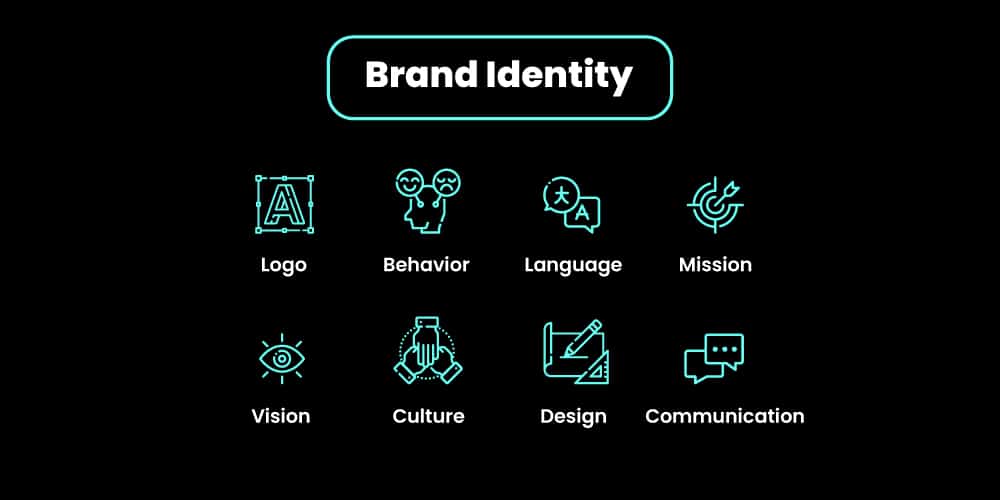
Importance of Brand Identity
A strong brand identity has several benefits for a business, including:
- Increased recognition: A well-designed logo and consistent visual elements make it easier for customers to recognize a brand.
- Differentiation: A strong brand identity helps a business stand out from its competitors.
- Consistency: When a brand has a strong identity, it’s easier to maintain consistency across every platform, whether it’s social media, packaging, or advertising.
- Trust: A professional, well-designed brand identity can help build trust with customers. According to Edelman, consumers are more than twice as likely to buy first, stay loyal, and advocate for brands they trust.
How to Build a Strong Brand Identity
Building a strong brand identity is important for a business that wants to stand out in a crowded market. You can use these brand management strategies to create a brand identity that will help you distinguish yourself from the rest.
- Develop a clear and consistent brand messaging: Your brand communication is the foundation of your brand identity. It should be simple, clear, and consistent across your website, social media, and advertising campaigns.
Recommended Reading: How to Align Your Social Media Strategy with Your Business Goals
- Create a visual identity that reflects your brand personality: Your visual branding elements, such as your logo design, colors, and typography, should be designed to reflect your brand’s personality and values.
- Understand your target audience: Understanding your target audience is essential to building an effective and strong brand identity. Research your audience to identify their needs, preferences, and behaviors. Use this information to create brand messaging and visuals that click with them.
- Define your brand values and personality: Brand values and personality are the guiding principles that define your brand identity. Clearly defining them will help create a consistent image and visual identity that resonates with your target audience.
- Be consistent across all platforms: Consistency is the key to building strong brand engagement. Be sure to use the same voice, tone, and visual identity across all channels. This will help customers recognize and remember your brand, building a strong brand identity over time.
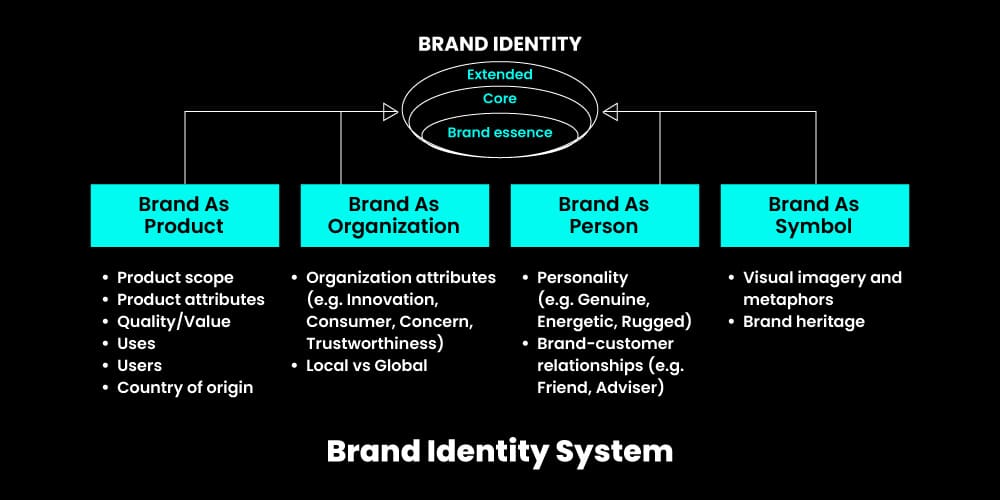
Examples of Companies with Strong Brand Identities
Here are some brands that excelled at creating a strong and memorable brand identity:
- Apple: Apple’s sleek, minimalist design aesthetic is easily distinguishable and reinforces the brand’s reputation for innovation and quality.
- Nike: Nike’s iconic “swoosh” logo and “Just Do It” tagline are instantly recognizable and convey a sense of energy and empowerment.
- Coca-Cola: Coca-Cola’s classic red & white color scheme and cursive font are known almost everywhere and evoke feelings of nostalgia and happiness.
Also read: 7 Successful Brand Taglines That Took The Internet By Storm
Importance of a Positive Brand Image
A positive brand image has several benefits for a business, including:
- Increased trust: Just like with brand identity, when customers have a positive image of your brand, they are more likely to trust it, thereby increasing brand loyalty.
- Competitive advantage: A positive brand image can help your business stand out from competitors and attract new customers.
- Willingness to pay a premium price: Customers are often willing to pay extra for products or services from a brand they have a positive image of.
- Word-of-mouth referrals: Customers who have a positive image of your brand are more likely to recommend it to their friends and family.
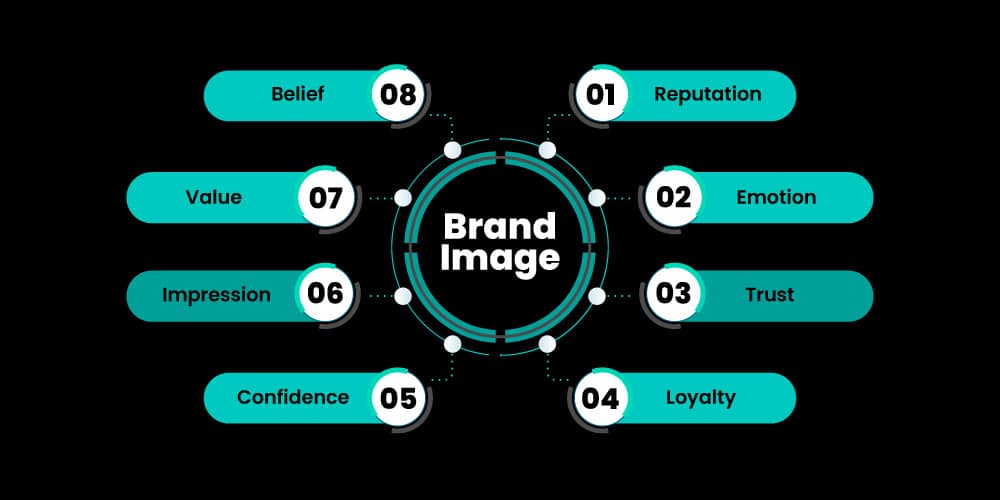
How to Create a Consistent Brand Image
Building a positive and consistent brand image takes time and effort. Still, there are several branding strategies you can utilize to strengthen your image, including:
- Consistency: A business should strive to deliver a consistent experience, from product packaging to advertising to customer service.
- Authenticity: Customers can sense when a brand is being disingenuous or trying too hard to appeal to them. That’s why being authentic and true to the brand’s values and personality is important.
- Customer Experience: Customer experience is a crucial component of brand image. A business should provide excellent customer service and make every interaction with customers a positive one.
- Social responsibility: Many customers today seek socially responsible and environmentally conscious brands. Businesses that demonstrate a commitment to these issues can strengthen their brand image.
- Public relations: A business should proactively manage its public image and respond to any negative press or feedback with respect.
Also read: How to Build a Strong Social Media Presence Using These 25 Tips
Examples of Companies with Positive Brand Images
Here are a few examples of businesses with a positive brand image:
- Patagonia: Patagonia is a brand that is widely known for being eco-friendly and socially responsible. Its customers see it as a brand that stands for something more than just selling outdoor gear.
- Amazon: Amazon’s focus on customer service has helped it build a positive brand image. Customers appreciate the convenience and reliability of Amazon’s services. According to Statista, this year, Amazon is the most valuable brand in the world.
- Airbnb: Airbnb has built a brand image around the idea of “belonging anywhere.” Its customers see it as a way to connect with new people and live new life experiences.
Understanding the Relationship: Brand Identity Vs. Brand Image
Brand Identity Vs. Brand Image: How Are They Interrelated
Think of brand identity as the blueprint and brand image as the final product. Just like how a house needs a solid foundation to ensure its structural integrity, a brand needs a strong identity to establish its essence and purpose. From there, businesses can build a captivating brand image that accurately reflects their values and resonates with their audience.
Brand identity comprises of the visual and verbal representation of a brand, which is used to create a consistent and recognizable image that resonates with the target audience. When customers interact with a brand, they form a perception of it, which is known as brand image.
Understanding that your brand identity is not set in stone is critical. A customer’s perceptions of your brand can shape and influence its identity, leading to changes in your brand’s visual and verbal expression to better connect with its audience.
This close relationship between brand identity and brand image means that a well-defined brand identity can help businesses create a positive and impactful brand image that resonates with customers on a deeper level.
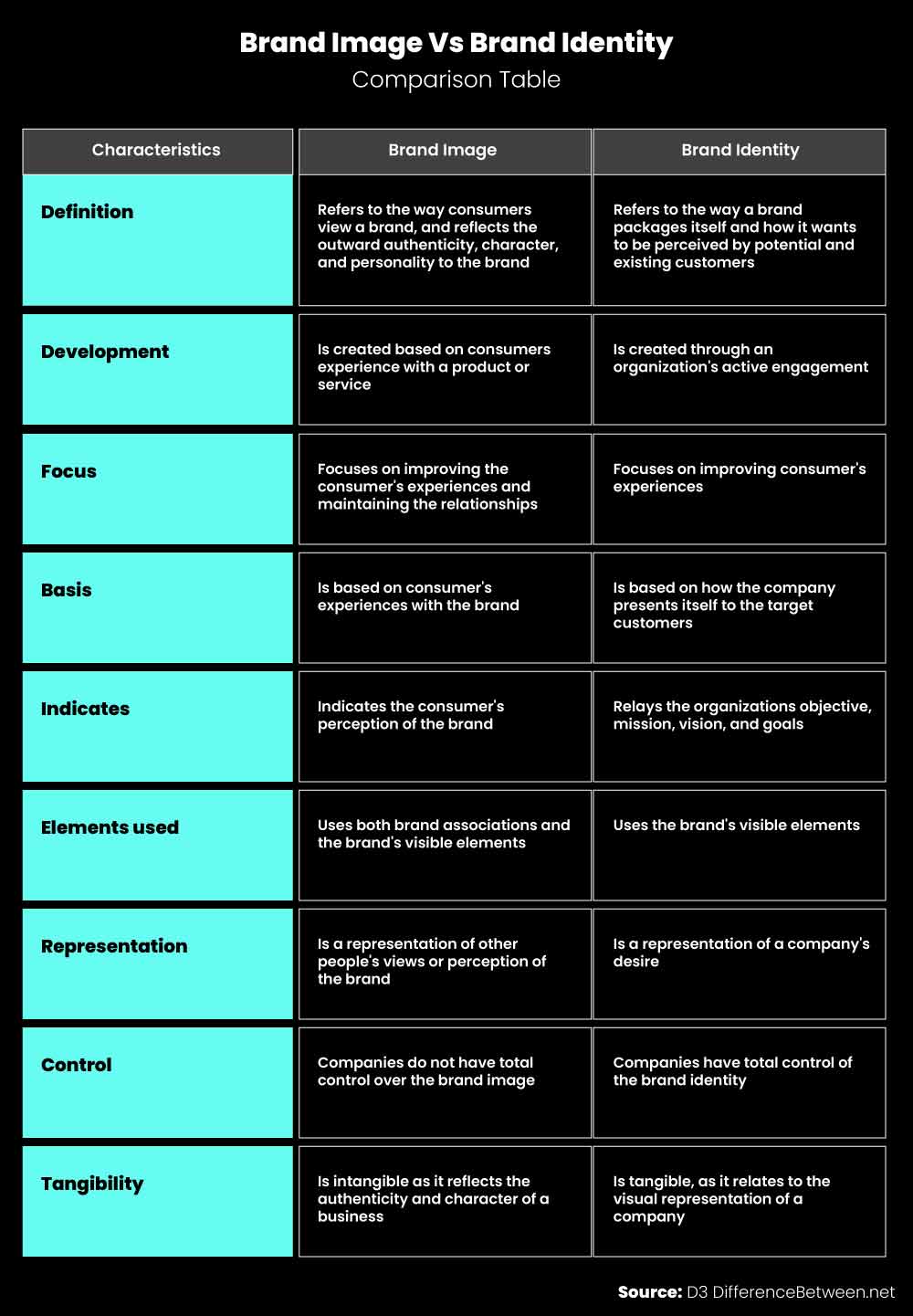
Brand Identity Vs. Brand Image: How It Differs
Think of brand identity as a brand’s attire – the outfit your brand wears to convey its personality and values to the world. On the other hand, brand image is the impression your brand leaves on its customers, just like how a person’s charisma and energy can evoke a certain emotional reaction from others.
While a well-crafted brand identity can set the tone for a brand, the emotional connection that a brand image creates with customers truly sets a brand apart.
For example, a brand might have a strong, consistent visual identity. Still, if consumer perception sees it as untrustworthy or unresponsive to their needs, it will struggle to build a positive brand image.
That is why you need strong brand reputation management strategies in place to boost brand recognition and customer engagement.
Also read: The Power of Visual Content in Shaping Brand Growth
Importance Of Aligning Brand Identity And Brand Image
It is essential for you as a business owner to strategically align your brand identity and brand image. If there is a disconnect between what the brand promises and delivers, customers will become skeptical and lose trust in the brand. When a business consistently delivers on its brand promises, it helps to build a positive brand image and brand awareness.
To emphasize the significance, a jigsaw puzzle can be a good example to explain the importance of aligning brand identity and brand image. Consider brand identity as the picture on the box that shows how the completed puzzle should look like, while the brand image is the actual puzzle piece that the audience sees and interacts with.
If the puzzle pieces do not fit together to create the picture on the box, it will be a frustrating and disappointing experience for the person trying to complete the puzzle. Similarly, if the brand identity does not match the brand image, it will lead to confusion and disappointment for the audience.
Just like how each puzzle piece needs to be in the right place to complete the puzzle, every aspect of a company’s branding needs to be aligned to create a cohesive and consistent brand experience for the audience. This includes everything from the logo and visual design to the messaging and customer service.
Examples of companies that have successfully aligned their brand identity and brand image
- Spotify: Spotify’s brand identity is centered around personalized music experiences, discovery, and accessibility. Its perceived brand image is of a user-friendly platform that offers a vast library of music and podcasts for users to enjoy anytime, anywhere.
- Lego: Its brand image is one of a fun and educational toy brand that sparks creativity and imagination in children and adults alike. Lego has successfully built a strong brand that is associated with innovation, quality, and nostalgia.
- Warby Parker: Warby Parker’s brand identity is centered around affordability, fashion-forwardness, and social responsibility. Its brand image is one of a stylish and affordable eyewear brand that has revolutionized the traditional eyewear industry. Warby Parker has successfully built a loyal customer base who appreciate its brand identity and trust its image as an innovative and socially responsible brand.
Brand Identity Vs. Brand Image: Why They Matter
Benefits of strong brand identity and positive brand image
- Increased customer loyalty and retention
- Competitive advantage
- Ability to charge a price premium
- Positive word-of-mouth referrals
- Ability to attract top talent
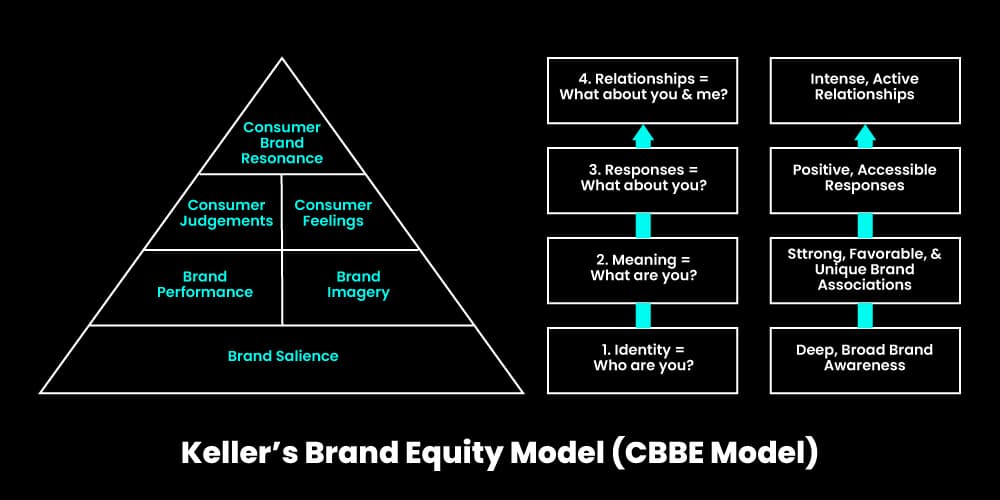
Risks of weak brand identity and negative brand image
- Difficulty attracting and retaining customers
- Loss of competitive advantage
- Decreased revenue
- Negative word-of-mouth referrals
- Difficulty attracting top talent
Examples of companies that have suffered due to weak brand identity or negative brand image
- Sears: Sears’ brand identity was once known for reliability and quality, but it has struggled to keep up with changing consumer preferences in recent years. The brand image has suffered as a result, and the company has struggled to stay afloat.
- Blockbuster: Blockbuster’s brand identity was once associated with convenience and access to the latest movies. However, the rise of streaming services disrupted the two main pillars of its business model, and the brand image suffered as a result.
- Enron: Enron’s brand identity was once associated with innovation and excellence, but it was later revealed that the company was involved in fraudulent activities. The negative brand image resulted in the company’s downfall.
Final Thoughts
When we talk about brand identity vs. brand image, both are crucial components of building a successful brand. As a result, a strong brand identity and positive brand image can lead to increased customer loyalty and can give you a competitive edge.
On the other hand, a weak brand identity or negative brand image can have numerous risks for a business. These risks can include everything from decreased revenue and damaged reputation to difficulty in attracting and retaining customers.
Therefore, you need to ensure that your brand identity and image are aligning with your brand values. This way, you will be able to build a lasting connection with your customers. To achieve this, you need to focus on being consistent and authentic. Additionally, you also need to ensure exceptional customer experience by adhering to your role of being a socially responsible brand to strengthen your brand image.
Did you find this article helpful? We will be posting more marketing tips in the upcoming weeks. Stay tuned to our blog, and never miss an update!

